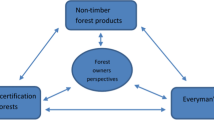Abstract
Malian Forest Service activities and policies have evolved since the beginning of colonialism under the assumption that forests and their products are the property of the government. Today the importance of involving local people in forest management is recognized. The purpose of this research was to determine the range of non-timber forest products local people use either for direct consumption or for income generation and to identify the trees/shrubs that yield these products in natural forests, fallow lands and crop fields. A gender analysis of the data was also conducted. The data were collected from face-to-face structured interviews using open-ended questions of 92 randomly sampled households in six Malian villages. One-half of the interviews were conducted with women and the other half were with men. The study identified 55 different non-timber forest products produced by 108 plant species. Almost all (99%) of the products identified are used for personal consumption, whereas 68% of the products are also used to generate income. Products such as firewood, leaves for sauces, shea nuts for oil/butter, seeds for condiments and nuts/seeds for soap are the most frequently mentioned products collected by women. Different categories of products like utensils/house materials, animal feed and construction materials (thatch, poles, mats) are the products most frequently collected by men. Ninety percent of the products collected are found in the natural forests; 63% are collected from trees on fallow lands and 51% from scattered trees in crop fields. Forest Service support of villagers using non-timber forest products would create an economic relationship between the forest and the local people. This is essential for the protection of the forest because people will safeguard their interests.
Similar content being viewed by others
References
Cernea MM (1989) Users groups as producers in participatory afforestation strategies. World Bank discussion papers. Washington DC, 80 pp
De Beer H (1989) The economic value of non-timber forest products in Southeast Asia with emphasis on Indonesia, Malaysia, and Thailand. Netherlands Committee IUEN-DANMARK, Amsterdam, pp 17–22
DNEF (Mali) (1985) Plan national de lutte contre la désertification et l'avancée du desert. Mali. Unpublished, 28 pp
Falconer J (1987) Forestry extension: a review of the key issues. Social Forestry Network. Network paper 4e. June 1987. ODI, Agricultural Administration Unit, London, 33 pp
FAO (Food and Agriculture Organization) (1978) Forestry for local community development. Forestry paper 7. Rome: FAO, 114 pp. In: Gregersen H, Sydney D and Dieter E (1989) The Role of Social Forestry in Sustainable Development. Economic Development Institute, World Bank, Washington, DC, 273 pp
FAO (Food and Agriculture Organization) (1982) The non-wood products of African forests. Unasylva 34(137): 15–21
Gakou M (1992) Non-timber forest products in rural Mali: a study of villager use. Unpublished MS thesis. University of Idaho, Moscow, 103 pp
Gellar S (1980) Village woodlot schemes and peasant survival strategies in Sahelian Mali. Paper presented at the Twenty-Third Annual Meeting of the African Studies Assoc, 15–18 October 1980, Philadelphia, PA, 19 pp
Gregersen H, Sydney D and Dieter E (1989) The Role of Social Forestry in Sustainable Development. Economic Development Institute, World Bank, Washington, DC, 273 pp
Hoskins MW (1982) Social forestry in West Africa: myths and realities, American Association for the Advancement of Science. In: Falconer J (1987) Forestry extension: a review of the key issues. Social forestry network. Network paper 4e. June 1987. ODI, Agricultural Administration Unit, London, 33 pp
Jackson JK, Taylor II GF and Conde WC (1983) Management of natural forest in the Sahel region. USAID/REPORT, 94 pp
Korten DC (1987) Introduction: community-based resource management. In: Korten DC (ed) Community Management: Asian Experience and Perspectives, pp 1–15. Kumarian Press, West Hartford, 328 pp
Miller JK, (1984) Secondary Forest Products of Species Native to the Dinderesso National Forest US Agency for International Development, Burkina Faso, 31 pp
Noronha R and Spears JJ (1985) Sociological variables in forestry project design. In: Cernea MM (ed) Putting People First. Sociological Variables in Rural Development, pp 225–266. Oxford University Press, 430 pp
Ohler FM (1985) The fuelwood production of wooded Savanna fallows in the Sudan zone of Mali. Agroforestry Systems 3: 57–62
Poulsen G (1978) Man and Trees in Tropical Africa: Three Essays on the Role of Trees in the African Environment. Ottawa, Ontario, IDAC, 31 pp
Author information
Authors and Affiliations
Rights and permissions
About this article
Cite this article
Gakou, M., Force, J.E. & McLaughlin, W.J. Non-timber forest products in rural Mali: a study of villager use. Agroforest Syst 28, 213–226 (1994). https://doi.org/10.1007/BF00704757
Issue Date:
DOI: https://doi.org/10.1007/BF00704757




